A mine for learning
A 5-foot square tunnel runs for hundreds of feet under the Fairbanks campus. This is not a utilidor, one of those passages for pipes and wires into which mischievous students occasionally sneak.
It’s older, deeper.
And students built this tunnel, for students. No sneaking was necessary to gain entry — just a little training and, sometimes, a paddle swat on the backside.
The University of Alaska Fairbanks began in 1917 with a more specific title — the Alaska Agricultural College and School of Mines. The tunnel, started shortly after the college opened for classes in 1922, helped make real the second half of its name.
It was a mine, or at least a rough model of one.
For decades, the tunnel, called an “adit,” helped give a dose of practical training to students learning from books and lectures in the buildings on the surface of College Hill. The adit has long since been plugged, but the emphasis on practical learning that it represented lives on at the university’s modern mining school.
The tunnel entered the hillside near today’s heat and power plant.
“It went in on the level, so I expect it must have been about 100 feet deep when it got under the university buildings,” said Ray Smith ’43 in an interview earlier this year. “There was a fairly good-size room right at the end.”
Smith served as president of the student Miners Society during his time at the college, so he not only took mining courses in the adit but also used it to initiate new society members.
“We had the new students go through the tunnel, which required them to stoop, since the adit was only about 5 feet from floor to roof,” he recalled in January, shortly after turning 100. [See profile.]
“Members of the society had paddles that they would whack the students’ butts with as they walked crouching along the tunnel,” Smith said. “They would straighten up and hit their head on the roof. That taught them the value of the miner’s helmet.”
That was just one lesson learned in the tunnel, where students went for their required course in practical mining techniques.
Patrick O’Neill ’41, ’53, ’76 (Hon.) learned how to throw dirt. That skill got him noticed and promoted a few years later, he said.
“One of the things I learned was, instead of taking a shovel full of dirt and turning around, was to throw it over your shoulder,” O’Neill said in an interview in January 2017. (He turned 102 in August.)
After each round of drilling and blasting at the tunnel end, students shoveled the loose rock and dirt, called muck, into small cars on a set of railroad-like tracks. They’d then push the cars out the tunnel by hand and dump them, O’Neill said. It was hard work but an expected part of the practical mining course.
During his college years, O’Neill often worked for the Fairbanks Exploration Co.’s dredging operation in Fox, just north of Fairbanks. One night, a tunnel that carried water to a dredge caved in, and O’Neill was called out to help.
“I was on the face shoveling and throwing it over my shoulder and working fast,” O’Neill said. “One of the big bosses at the F.E. Co. came out … and he asked the foreman, ‘Who’s that kid up on the face doing the shoveling?’”
The “big boss” was Jim Crawford, the F.E. Co.’s Fairbanks manager, and he offered O’Neill a promotion.
“He said, ‘Next spring, come to see me and I’ll get you into the engineering work,’ which I’d been trying to do,” O’Neill said. “I’d spent five years on the pick and shovel.”
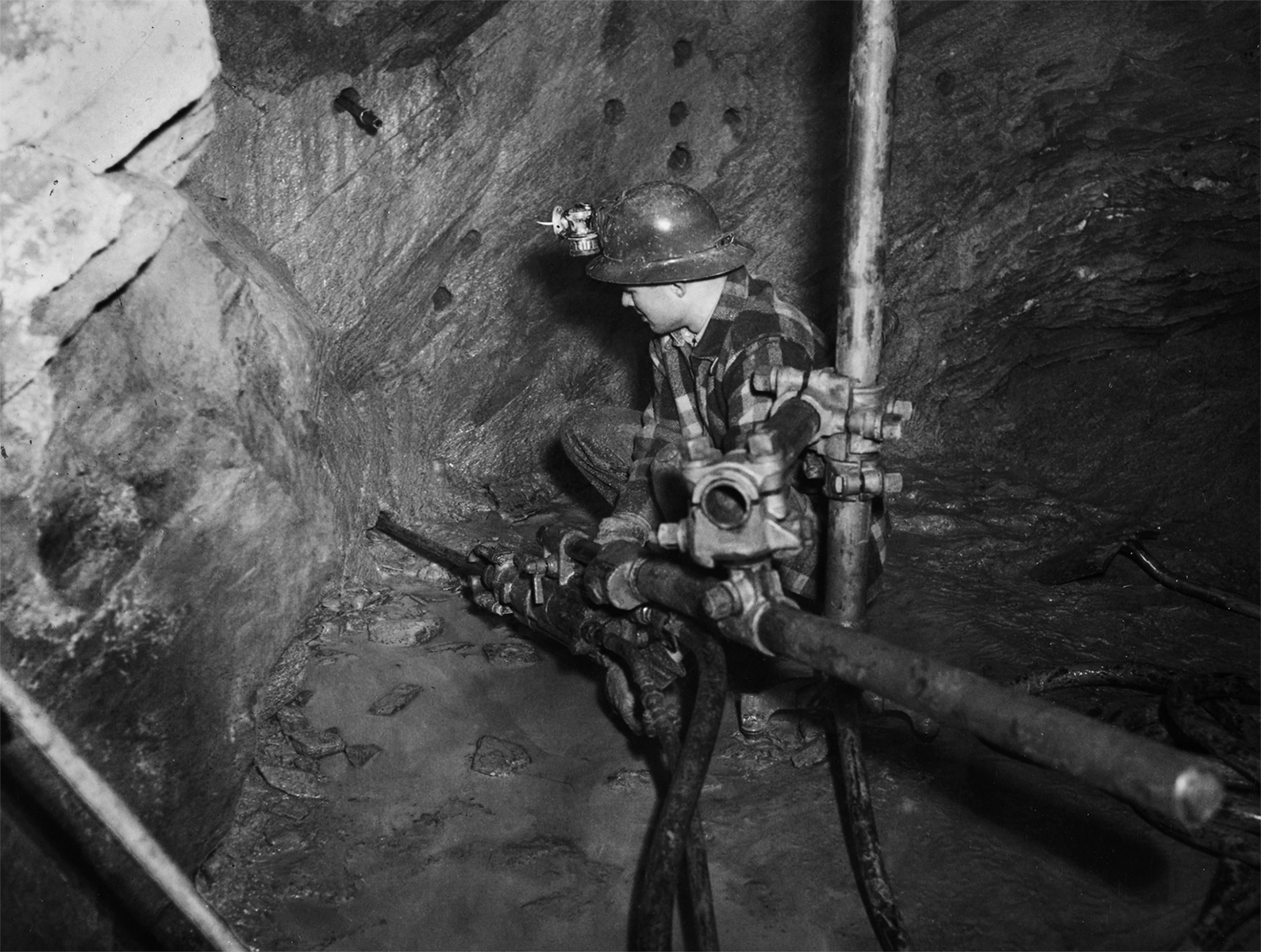
Students in the university’s mining program labor in the model mine operation, which the university established early in its history to give students practical experience. At top, a student in the training adit, the university’s mine under campus, guides a drill into the rock to make a hole for an explosive charge.
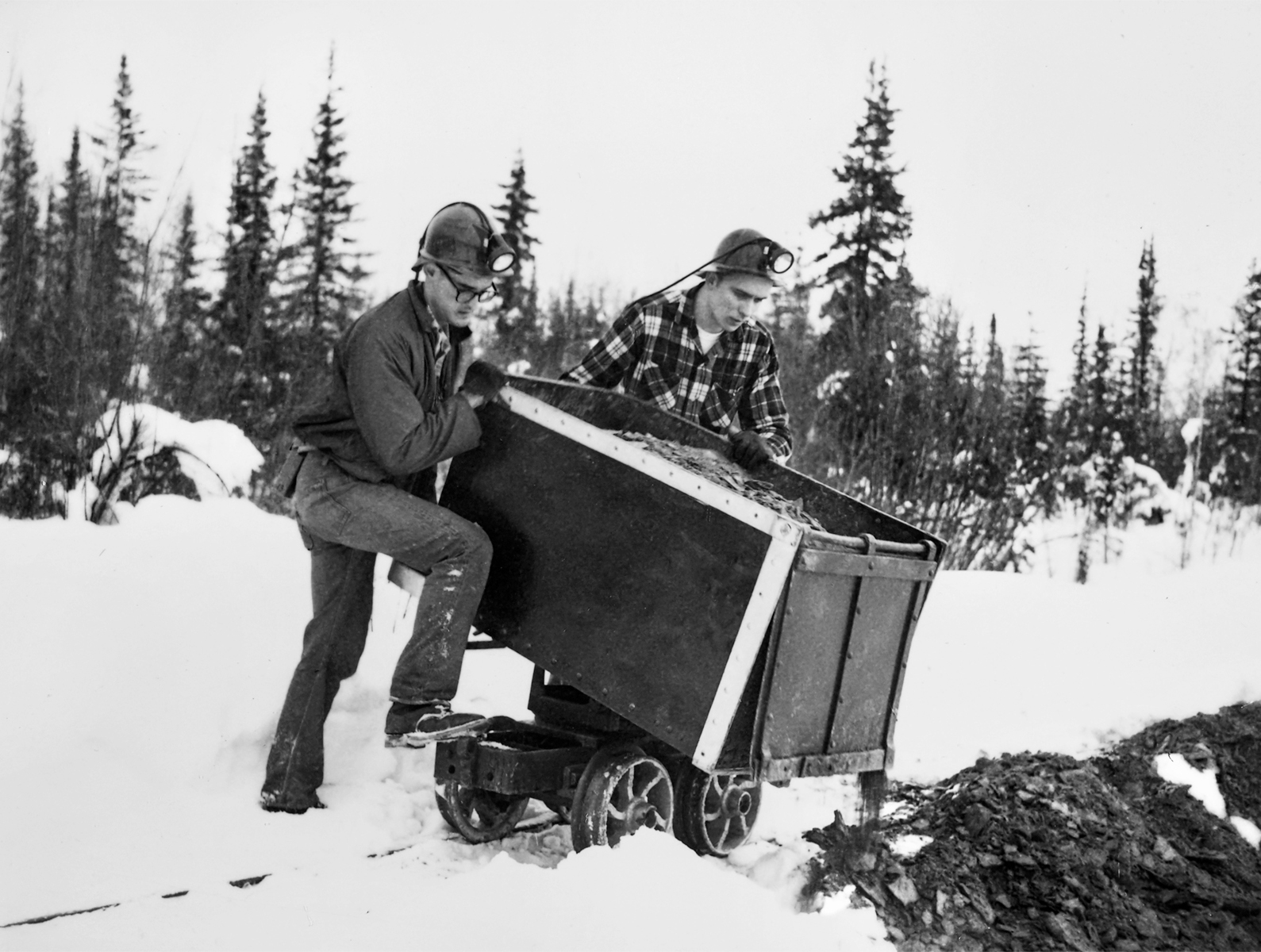
Students dump a rail-mounted cart after mucking out the results of a winter blast in the adit.
Overcoming the obstacles
Both O’Neill and Smith, who started as nearly destitute students, went on to distinguished careers. After working his way up to dredge superintendent at the F.E. Co. and earning a master’s in 1953, O’Neill took a job running a mine in South America and became an executive in several international mining companies. Smith, after a stint as a faculty member at UA, went on to the presidency of Michigan Technological University from 1965 to 1979.
They credit their success not only to their training in Fairbanks but also to financial assistance and encouragement from Charles Bunnell, the university president from 1921 to 1949. Bunnell and his faculty overcame the adversities of a remote location to create a high-quality model mine, and he recruited students vigorously.
“He was determined to get something going. He was very resourceful and creative,” said Leslie Noyes, who interviewed more than 300 people from the late 1980s through 2000 while writing “Rock Poker to Pay Dirt: The History of Alaska’s School of Mines and its Successors.”
Noyes, who now lives in Golden, Colorado, noted that Ernest Patty ’53 (Hon.), the School of Mines’ first geology professor, outlined his thinking in an article for the March 1928 edition of the campus newspaper, the Farthest-North Collegian.
“There are too many graduates from our mining schools who lack the confidence to go into a mine, set up a machine, drill and blast a round, and put in a set of timbers,” Patty wrote. So he required School of Mines students to take at least one course in practical mining. The first year, they dug 156 feet of tunnel, Patty reported.
Patty and Bunnell also put together a collection of more than 2,000 mineral specimens that was “one of the most complete in Western America,” according to an article in the February 1924 Collegian. “These are not sealed away in museum cases but are available for close examination and detailed study … to serve the needs of the engineering students and the men who come in from the ‘hills’ each winter to take the short course for miners and prospectors.”
We had the new students go through the tunnel, which required them to stoop, since the adit was only about 5 feet from floor to roof.”
Students began digging the adit immediately after the college opened in 1922, Noyes reported.
“They secured timbers for the mine by wading through deep snow to cut spruce trees from the flats,” she wrote. “The finished model of a mine consisted of a timbered adit with air and water lines, a blacksmith shop and compressor house.”
Digging ore from a hill is only the start of the mining process, though. To simulate a real operation, the school obtained a small mill with two stamps to crush the ore. Another mill did a similar job using steel balls in a cylinder. The operation also had a classifier to recycle ore that didn’t get crushed well on the first try. A flotation cell allowed the ore to be treated with chemicals to separate the gold.
If there was gold, that is. The ground under the Fairbanks campus didn’t seem to hold any obvious worthwhile minerals. So the model mine also tested ore from miners around the area and turned over the results.
Smith recalled also stuffing Mining Society initiates into some kind of a rotating barrel separator during rites. “It was a tough go for the new students, but effective,” he said wryly.
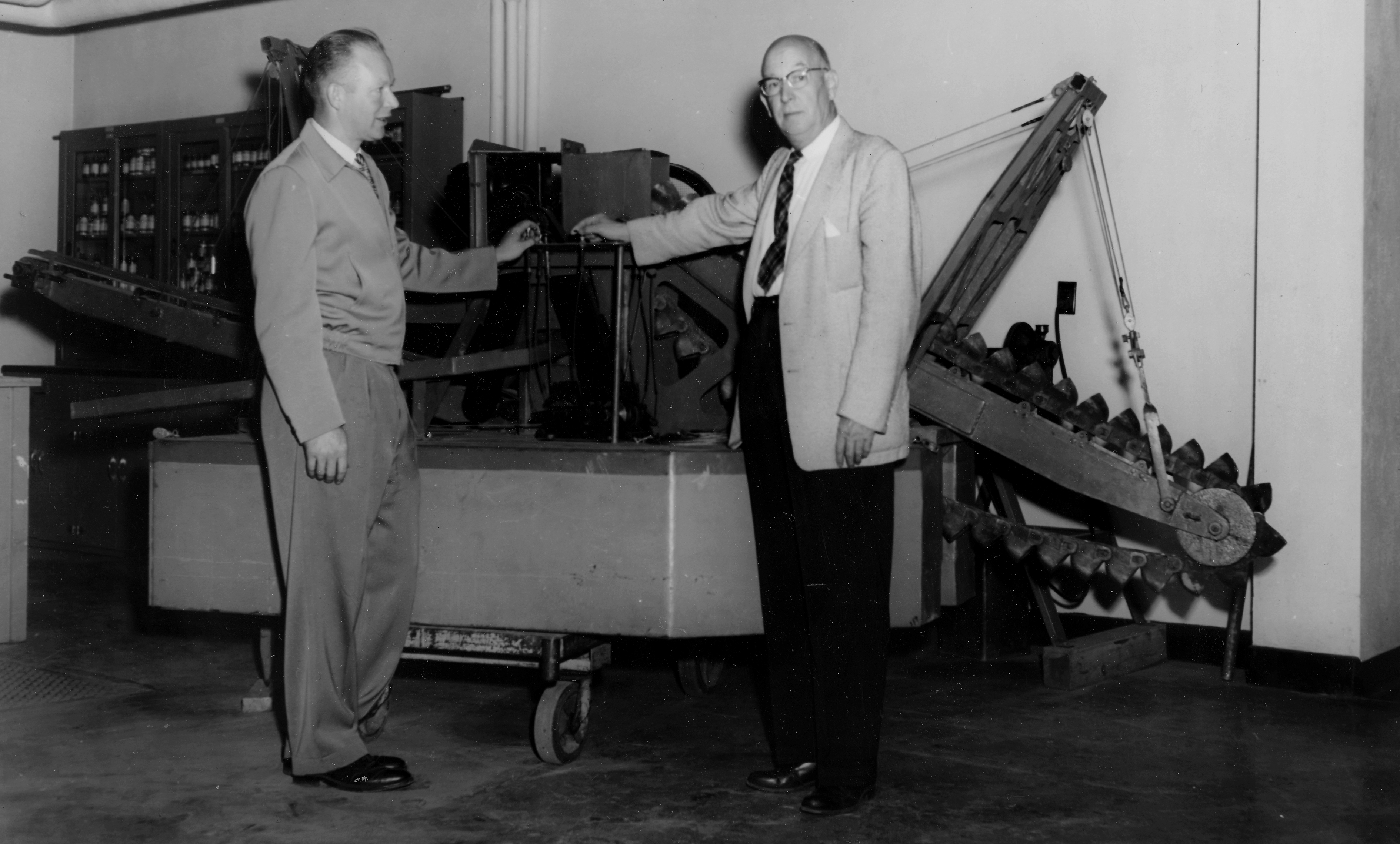
School of Mines Dean Earl Beistline, left, and UA President Ernest Patty inspect a working model of a gold dredge, No. 2 1/2 Nyac. William Race ’42 gave the model to the university in 1958, 20 years after it was built for the New York Alaska Gold Dredging Corp. The company operated full-size dredges at Nyac in Southwest Alaska. Such dredges were an important source of employment for students and graduates of the university’s mining programs.
Looking for work
By the late 1930s, the mining school had become the dominant academic enterprise within the university.
In 1941, just before World War II decimated enrollment, the university graduated its largest class to date, Noyes noted. Of the 35 graduates, 15 came from the School of Mines. Of the 307 students enrolled in the 1940-1941 academic year, 88 were in mining. In addition, about 500 students took short courses in communities around the state, Noyes reported.
People entered the field because they could see it offered a chance of employment, said Paul Metz ’75, a UAF professor of geological engineering in the Department of Mining and Geological Engineering, the descendant of the School of Mines.
After studying at Michigan Tech while Ray Smith was president, Metz came to Alaska in 1968, earned his master’s in 1975 and has worked at UAF since.
“During the Great Depression, there were no jobs anywhere else,” Metz said. “That’s how Ray Smith and his partner came here in the late 1930s, looking for work.”
Students also found ready summer employment at the F.E. Co. dredges or other mines in the state.
“The biggest source of training of all, hands-down, were the dredges,” said Tom Bundtzen ’73, ’81, president of Pacific Rim Geological Consulting in Fairbanks. Bundtzen earned a bachelor’s in general geology and then a master’s in economic geology. [Bundtzen’s brother, Bob, see profile.]
Bundtzen, as president of the Alaska Mining Hall of Fame, has spent many hours researching and writing biographies of inductees. He found that the F.E. Co., a subsidiary of the U.S. Smelting, Refining and Mining Co., employed numerous students both during their college years and afterward.
“Many of their engineers, who would later become dredge superintendents and dredge masters, came out of the university,” he said.
In need of experienced faculty, the university also drew upon former students who had supported their educations and careers through mining.
Earl Beistline ’39, ’47, ’69 (Hon.), who served as dean of the mining school from 1949 to 1982, as a student had worked summers for the F.E. Co. driving cold-water points to thaw the ground before dredging.
“USSRM hired most of us and kept us interested in our studies,” Doug Colp ’40 told Noyes. In 1965, Beistline hired Colp, by then an internationally recognized dredging and placer mining expert. Colp taught for the next decade.
Ernie Wolff ’41 worked at various Alaska mining enterprises before earning a doctorate in Colorado. He returned to lead the university’s Mineral Industry Research Laboratory from 1969 to 1983.
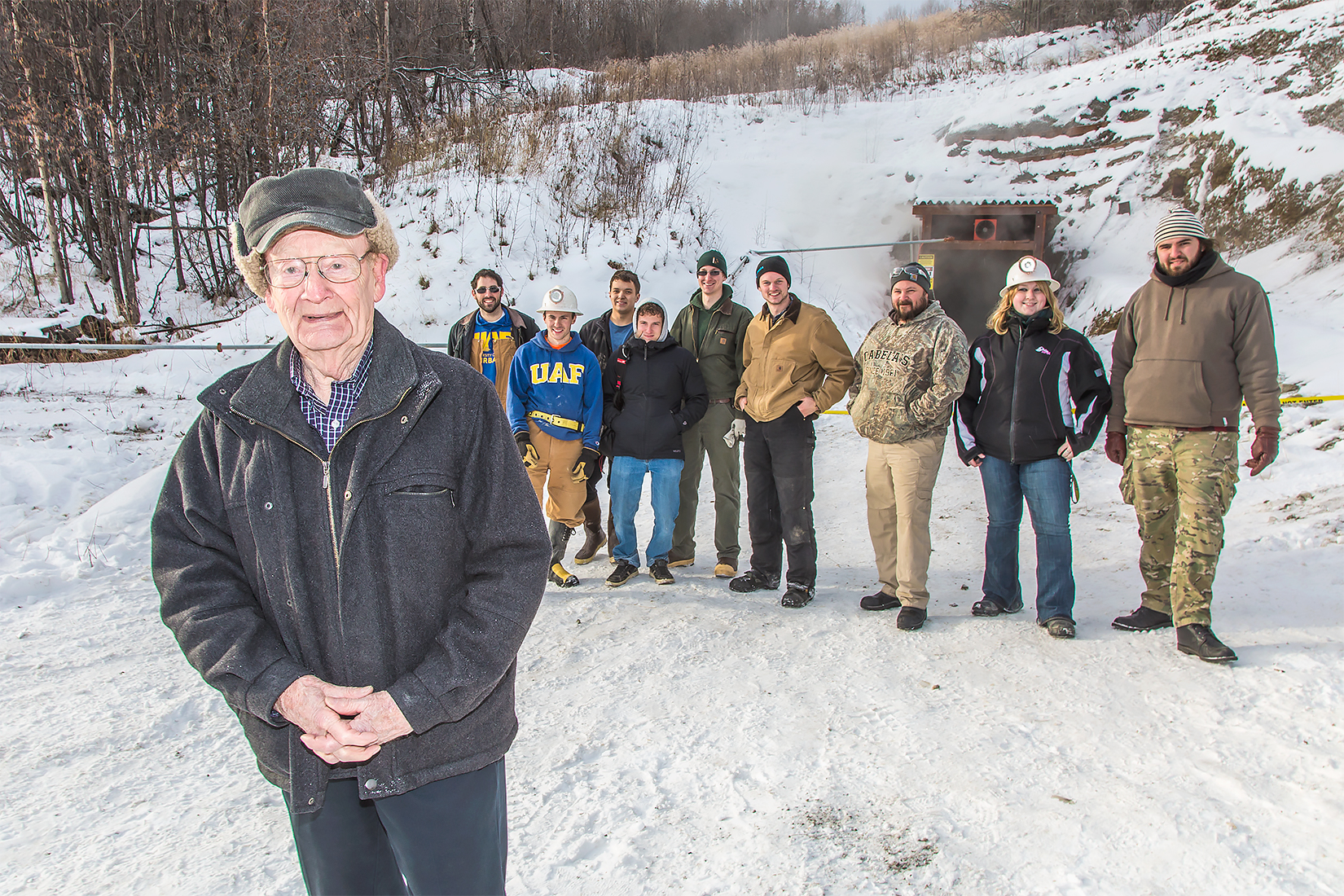
Garth Anderson joins mining students who were restarting work at the Silver Fox Mine in 2014. Anderson’s father, Tury, staked the claims after World War II and donated them to UAF in 1977. The mine is located off the Elliott Highway near its intersection with Old Murphy Dome Road. Students are in charge of the mine, which gives them real-life experience with the challenges in running a safe, efficient operation.
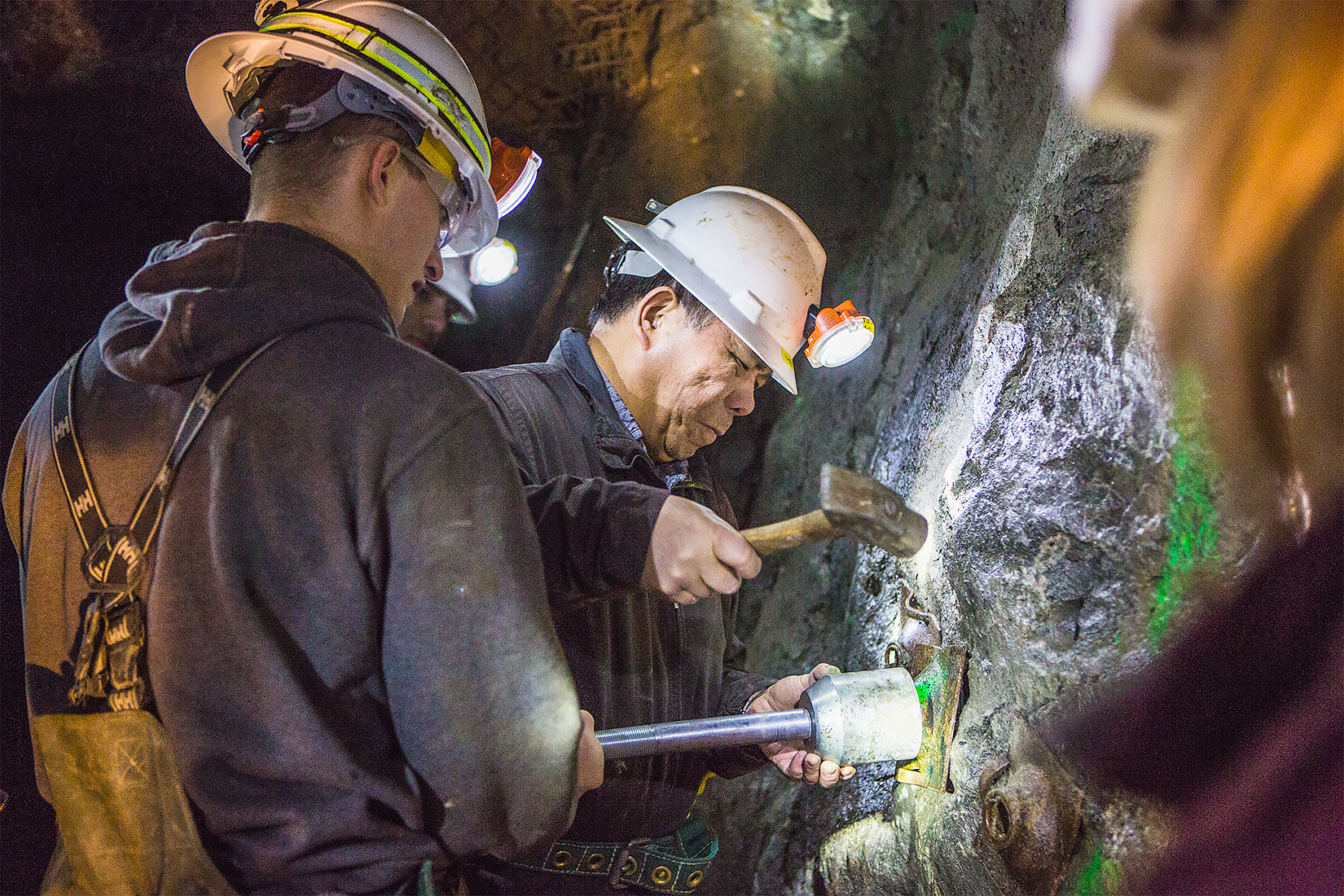
Mining and geological engineering Professor Gang Chen leads a Rock Mechanics lab at the Silver Fox Mine in April 2017.
Extracurricular blasting
After World War II, Alaska’s dredges declined, and all but one shut down by 1965. Nevertheless, the School of Mines continued to enroll a record number of students, and the model mine continued to operate. Photographs from the 1958 yearbook document students drilling, blasting and mucking out the mine.
However, it closed shortly afterward when administrators grew worried about the blasting and drilling, Noyes reported. A few incidents in the mid-1950s made such worries more than theoretical.
I’m glad my boys can handle powder, but there’s a time and place for it.”
The night before a hockey match with civil engineering students, the mining students drilled into the rink, planted some dynamite and blew holes in the ice. That was easily corrected with some water that refroze, but another incident was less benign.
Shortly after Ernest Patty returned to the university as president in 1953, mining students with access to the dynamite set off an outdoor charge to liven up a student dance. The explosion blew out windows in Nerland Hall and the Chapman Building.
Because Chapman at that time housed the federally chartered Geophysical Institute, the FBI investigated. The perpetrators were caught and fined.
I’m glad my boys can handle powder, but there’s a time and place for it,” Patty reportedly said afterward.
After the adit closed, practical mining courses moved for a time to Beistline’s Blue Bird claims near Ester. Beistline gave the claims to the university in 1960.
Charles “Chilkoot” Ward ’86, UAF’s current director of utilities, said no visible trace remains of the university tunnel’s mouth today. The power plant operators do have one artifact from the adit — an ore car they use as a flower pot.
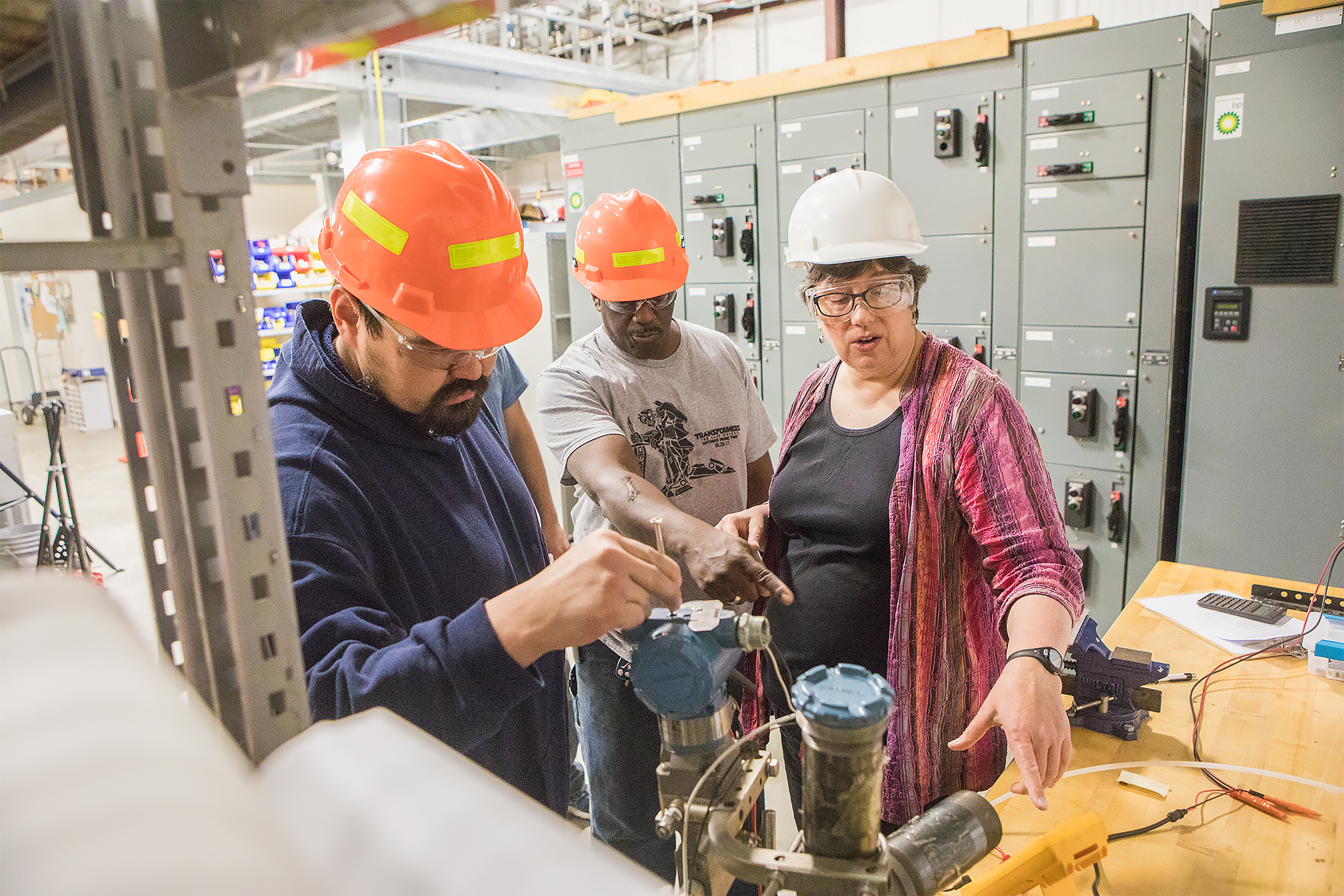
Students Glen Morgan, left, and Ernest Holt, center, listen as Teresa Lantz, assistant professor of process technology, demonstrates how to use a bubbler to monitor water levels in a tank in July 2017. Morgan and Holt were participating in the UAF Community and Technical College’s mining mill operator training program at a facility leased from the Fairbanks Pipeline Training Center off Van Horn Road.
Industry ups and downs affect school
Interest in the mining school waned along with the industry’s fortunes during the 1960s, Metz and Bundtzen said. The program underwent several reorganizations and name changes.
“There was a 20-year period when there wasn’t a whole lot going on, and that ironically was the period of time when I was going to school,” said Bundtzen, who arrived in 1968 as a biology major.
We are open enrollment; we are not selective, yet you see our little program up there with the best universities in the world.”
In the mid-1970s, Metz helped Wolff, the MIRL director, teach mine surveying, which requires a tunnel.
“We were bemoaning the fact that the little adit was gone,” Metz said. “We actually did the work in the utilidors, which was terrible because it was so bloody hot in there even in the late spring, and the same in the fall.”
Interior Alaska’s mining industry began to recover in the late 1970s and early 1980s, Metz said. Gold prices rose dramatically. Metz and others at the university received multiple federal and state grants to do detailed mineral assessments across Interior Alaska.
“That database provided a huge, huge impetus for exploration by the private sector,” he said.
The exploration led to two major gold mines — Fort Knox and Pogo. Several other potential large mines are under study.
The resurgence of mining has helped rejuvenate the mining program at UAF. Kinross, which operates Fort Knox, and Sumitomo, which operates Pogo, have donated more than $2 million each to a mining endowment at the College of Engineering and Mines.
The university reacquired a model operation in 1977 when longtime Fairbanks miner Tury Anderson donated his Silver Fox Mine, just off the Elliott Highway north of Fox. UAF faculty can now use it to teach mine surveying, rock mechanics and exploration geophysics. As in the old days, students do the work.
“There is a faculty member in charge, but the students run it,” said Rajive Ganguli, professor of mining engineering and the current director of the Mineral Industry Research Laboratory.
Two years after UAF received the Silver Fox Mine, the statewide university system also created the Mining and Petroleum Training Service in Southcentral Alaska to provide short, nonacademic training courses. In 2015, the service purchased the Delta Mine Training Center, located 30 miles southeast of Delta Junction. Management of the training programs recently moved under the UAF Cooperative Extension Service umbrella.
Modern mills use highly computerized systems, but instruction in their use is generally weak, Ganguli said. So UAF recently developed a “dynamic mill simulator” for students to use. On a computer screen, students can change the RPM of a rock-crushing drum, adjust a belt’s speed or add more water, all in a virtual mill.
They’ll see instantly how their actions affect the entire system.
“It’s very similar to what an operator would see,” Ganguli said.
Researchers at MIRL worked with instructors at UAF’s Community and Technical College to create the simulator, using a grant from the U.S. Department of Labor. The simulator first will be used in CTC’s two-month mill operator training program but then will be available free to anyone.
The Department of Mining and Geological Engineering also tries to keep its faculty grounded in the industry, Ganguli said.
“We usually do not hire faculty unless they have practical mining experience,” he said. “We don’t want armchair mining engineers.”
The approach seems to be working, Ganguli said. Senior capstone projects have done quite well recently in international competitions, he said. Mining Global magazine ranked UAF in the top 10 U.S. colleges for mining in February 2015. In February 2017, a UAF mining engineering team won first place in the mine design competition for students held during the Society of Mining, Metallurgy and Exploration’s conference in Denver, Colorado.
“We are open enrollment; we are not selective,” Ganguli said, “yet you see our little program up there with the best universities in the world.”
That status began in a tunnel that now lies empty some 100 feet under Charles Bunnell’s statue in Cornerstone Plaza on the Fairbanks campus.
The history is closer to the surface than it appears. Alumni installed Bunnell’s statue
in 1988. Among the organizers of the effort was Patrick O’Neill — the man who learned
how to handle a shovel in the tunnel below. ![]()



